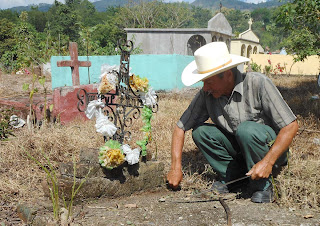Imagine the garbage ethos of 1950s-North America overlaid with the acute environmental sensitivity of the modern-day world, and you've got the Honduras dilemma.
People are still dropping garbage on the streets here. They're chucking it out of the windows of their cars. Shredded plastic, rusted tin cans, chip bags and pop bottles are common sights along rivers and creeks, as are garbage-strewn spots along the road that residents without municipal garbage services have turned into dumps.
Yet the country also has educated, affluent citizens influenced by the Internet, television and all those other forms of media that carry word of global campaigns to reduce, reuse and recycle. Pushed by countries with 50 or more years of garbage awareness under their belts, the arrival of such campaigns in a pre-Litterbug country creates a confused response.
So it is that twice in the last week, I've found myself listening to presentations about reducing the use of plastic bags in Honduras.
This is a popular theme in countries like Canada, where some grocery stores now leave you with no option but to either get it together around reusable shopping bags or stagger out the door with your loose purchases balanced precariously in your arms.
I'm all for fewer plastic bags, of course. I've
read the scary stories about the impact of plastic bags on our environment, and am diligent about bringing my reusable shopping bag whenever I go to the store.
But I do fear that we'll soon see anti-bag campaigns funded by developed-world dollars in a country that has yet to engage its citizens or local governments on much more basic messages around littering.
It's rare to see a public garbage bin here, and even rarer to see one get emptied before the garbage has spilled over the sides and been torn apart by all the wandering, starving dogs. Surely that's the first step - make it easy for people to choose a different option for disposing of their garbage.
Then comes the campaign in the schools. It's accepted theory that to change culture you start with the children, who then badger their parents into changing their behaviour.
Meanwhile, somebody has to take a look at how the grown-ups are handling things. My town of Copan Ruinas does a heck of a job picking up residential garbage three times a week, but the trucks merely transport the garbage to the sewage settling ponds and dump it behind a retaining wall that runs right alongside the Copan River. You can't shift a cultural mindset without also holding local government's feet to the fire around waste management.
Then there's the virtual absence of municipal staff designated for street cleanup. Somebody from the municipality must empty the four garbage bins in Copan's main park
, but it's pretty obvious that they don't do it often or feel any sense of urgency around returning the emptied bins. Everywhere else, garbage builds up on the street until some frustrated resident rakes it up and sets it on fire.
Maybe it's the broken-windows theory at play, but I see garbage build up quickly anywhere there's an empty building or vacant lot. Residents appear to do a good job of picking up the litter that accumulates on the street outside their homes, but who takes responsibility for the rest?
It could be a service club, a school, a volunteer group or city hall. It could be neighbourhood associations or local businesses. (Some of the earliest North American anti-litter campaigns were launched by local business groups.) I'd love to get the owners of Copan's "cantina row" working on a cleanup of the street across from their bars, a main entrance for tourists and one of the most litter-strewn streets in town.
But whoever ends up taking the lead, it won't just happen out of thin air. First comes the work to raise awareness that something needs to be done, then comes the work to designate just who that is. And in Honduras, you have the added challenge of figuring out who can even start the ball rolling, because community groups are scarce and all levels of government shirk responsibility.
When you think about all the initiatives that wealthy countries have undertaken in the last 50 years to reduce garbage, you realize what it takes - and how difficult it will be for developing countries to catch up.
Fueled by our well-resourced tax base, we've got high-tech, no-smell landfills in places that no citizen ever has to lay eyes on. We've got expensive bottle-deposit programs, elaborate at-the-curb recycling services, and large municipal departments and government ministries dedicated solely to waste management.
We've got multi-level dumping fees that motivate us by way of our (ample) pocketbooks to reduce, reuse and recycle. We've got costly systems at our landfills that remove toxic methane gas from rotting garbage and convert it to electricity for our homes. We've got at least four generations of citizens with anti-littering messages burned into their brains, and more than enough highway police and vigilant citizens to keep watch for anyone brazen enough to throw garbage from a car window.
Countries like Canada and the U.S. have great garbage habits not because there's something intrinsically tidy about us, but because we've spent a fantastic amount of time and money over five decades to make that so.
Lucky us that we've advanced to the point of now being able to consider the lowly plastic bag. But Honduras has miles to go before disposable shopping bags will ever be the answer to its problems.






.jpg)




.jpg)






.jpg)

.jpg)
